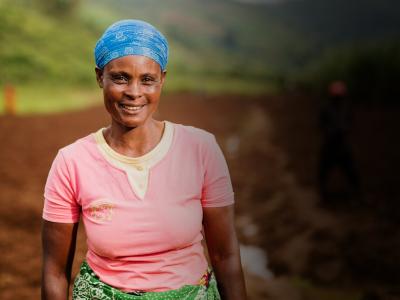Increased Political Action Needed for Women Survivors of Conflict
Last year, an independent study was commissioned by the U.N. Secretary General which set out to review how well governments and the international community were implementing international laws to protect women affected by conflict, specifically UN Security Council Resolution 1325. The study concluded that, despite some progress, 1325 and the wider Women, Peace and Security Framework, were far from standard practice. This includes:
-
Woefully low levels of women’s participation in peace and state building processes;
-
A failure of governments to develop and implement national effective plans;
-
A lack of funding to support women’s rights in conflict.
In particular, the study noted a lack of support for local women’s groups who are front-line responders for other women affected by conflict and who lead on advocacy efforts for long-term change from the grassroots to the international levels.
 Photo: Mark Darrough
Photo: Mark Darrough
For marginalized women, however, the Framework’s basic and fundamental protections are largely unknown and out of reach. While 1325 was originally a result of the women’s rights movement in 2000, there is now a large gap between the two as few women’s networks or organizations find it an effective advocacy tool as many governments are disengaged.
How the international community has responded to the study
The findings from this global study were presented to the international community at the U.N. Security Council and the international community made various commitments to step-up support for women affected by conflict. The UK, for example, promised to “shine a torch” on women survivors of conflict to ensure that their voices are heard, and revise its military doctrine to make it gender-sensitive.
It’s impossible to imagine that, twelve months later, we would really see a complete revolution in women’s rights in conflict, so that all women, even the most marginalized, enjoy their rights or justice when those rights are violated. But shouldn’t we have seen some progress, particularly along the more specific commitments made by governments?
Results have been mixed. At the recent UN Peacekeeping Defence Ministerial, for example, there was progress on increasing numbers of women peacekeepers and greater integration of women’s needs and gender perspectives into all aspects of peacekeeping (great). But there was little to no space for women’s groups or organisations to be heard or consulted with (not great).
At the grassroots level, in the communities where Women for Women International works, there has been little change for women with many situations deteriorating. In South Sudan, for example, a fragile peace agreement failed earlier this year and more than 2.5 million people have been displaced since December 2013.
What action do we want to see?
Without doubt, the Women, Peace and Security Framework is an important tool to help women affected by conflict. But its success is dependent on the genuine and effective implementation by governments and the international community which we desperately need to see more concrete steps taken to strengthen women’s participation in all peace and security decision-making and increase investment in women’s organizations. This is not just about rights education or awareness raising. This is about governments and the international community delivering on commitments.
We recognize the Framework’s importance and are proud to have joined with more than 250 other organizations from 55 countries to report on progress ahead of this year’s debate at the UN Security Council (October 25th).
Concrete, political actions by government and the international community are long overdue for women survivors of conflict. We simply cannot tolerate inaction.
